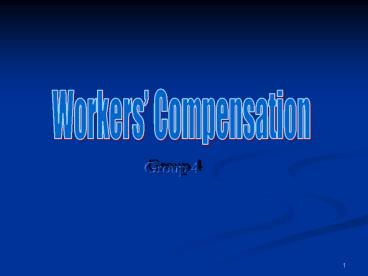Workers’ Compensation - PowerPoint PPT Presentation
Title:
Workers’ Compensation
Description:
Group 4 Workers Compensation and The Three Parts Workers Compensation is a social insurance program that provides: Medical care Cash benefits Rehabilitation ... – PowerPoint PPT presentation
Number of Views:58
Avg rating:3.0/5.0
Title: Workers’ Compensation
1
Workers Compensation
- Group 4
2
Workers Compensation and The Three Parts
- Workers Compensation is a social insurance
program that provides - Medical care
- Cash benefits
- Rehabilitation services
- Three coverages are provided workers
compensation insurance, employers liability
insurance, other-states insurance
3
Objectives and Eligibility Requirements of
Workers Compensation
- Provide broad coverage
- Substantial protection
- Provide sufficient medical care/rehab
- Reduction of job related accidents
- Reduce litigation
- Two principal eligibility requirements must be
met
4
Workers Compensation Benefits
Keep the benefits coming!
- Unlimited medical care
- Disability-income benefits
- Death benefits
- Rehabilitation services
5
Workers Compensation Mess in California
- Rates were falling due to set rates without state
approval - Insurers competed for business
- Carriers selling insurance at a loss to gain
market share - Firms became insolvent
6
Workers Compensation Mess in California (Cont.)
- Businesses pay highest premiums, but injured
workers get the lowest benefits. - Costs paid by employers are the highest in the
country. - Average employer pays 5.2 of payroll.
7
Problems Issues
- 30 of claimants who miss work hire a lawyer
- Doctors patients have little incentive to
restrain costs - Employers often hire dueling doctors
- California gives lots of discretion
- Unnecessarily complex, difficult to administer,
some cases outdated
8
Problems Issues (Cont.)
- Difficulty finding workers comp. Insurance
- California receive lowest disability benefits
- California has highest litigation and medical
cost - Last year, job based insurance premiums increased
by an average of 10 - Nearly 1 million claims filed each year
9
Problems Issues (Cont.)
- Standards of disability awards
- Stricter guidelines for permanent- partial
disabilities - Physician choice
- California exceeds national norm
- Workers file more claims than elsewhere
- Medical cost in California far above average
10
Problems Issues (Cont.)
- Lack of fee schedule
- Delays in updating existing fee schedules
- No fault system
- Rising medical inflations
- Indemnity
- Underwriting performance
11
Workers Compensation Fraud
- What is workers compensation fraud?
- The two most common types of workers
compensation fraud - Premium
- Benefit fraud
- Health care provider or attorney assists the
worker in fraudulent schemes, or participates in
double billing.
12
Workers Compensation Fraud (Cont.)
- In 2002-03 there were 660 fraud cases
representing more than 54 million dollars in
chargeable fraud - Humboldt man was charged with 6 Felony counts for
defrauding workers comp. - 7.1 billion in 1993 to 29 billion in 2003
- Fraud estimated to be between 1 to 3 billion
13
Workers Compensation Fraud (Cont.)
- Fraud committed by companies
- Falsely declaring number of workers
- Falsely declaring number of hours
- California passed AB227
- Before legislation
- 50,000
- Now
- 150,000
- Investigation department
14
Video
- Workers Comp. fraud
- It affects us all
15
Current Claims and Costs in California
- Reserves more than doubled from 9.5 billion in
1995 to 25 billion in 2002. - Medical Expenditures skyrocketed from 2.6 - 5.3
billion. - Claims have been declining, but savings have been
offset by rising medical costs.
16
The Rise In Cost
- Substantial increases in medical costs per claim
- Average medical cost per claim in 2002 was
31,000. - California employers pay more in Workers
Compensation premiums than any other state. - 40 states premiums average less then 4.00 per
100 of payroll - California averages 6.50 per 100 of payroll
17
Current Claims Cost (cont.)
- California has difficult political environment
for business. - Between 1997 and 2000, indemnity claims increased
230. - 62 of claim dollars go to medical bills and not
weekly benefits. - Excessive use of prescription pain medication.
18
Current Claims Cost (Cont.)
- Hospital Cost totaled 1.1 Billion in 2002.
- Chiropractor visits per claim up 70
- Pharmaceutical service has grown 243
- 86.4 million in 1997 to 296.6 million in 2002
19
(No Transcript)
20
Table 1 Service Utilization in California vs.
Other States
21
California Legislation
- AB 749 was passed on February 4, 2002
- Bill provides first increase in workers
compensation benefits for injured workers since
July 1, 1996. - Mandates return to work programs
- Also provides pharmaceutical and outpatient
surgery fee schedule - New requirements for enforcement of illegally
uninsured employers.
22
Reform Plan
- Propose to cut workers compensation rates in
half. - Which would result in 5 Billion in savings.
- Democrats have stated that the reform package
would reduce workers compensation cost by 14.9. - Plan will also increase the burden of proof for
claims of cumulative injuries that builds over
time.
23
Proposed Solutions To Workers Compensation
- To regulate the amount of chiropractic and
physical therapy visits per claim. - Strict guide lines of medical treatments.
- Make fees for outpatient surgery centers tied to
Medicare rates and pharmaceutical prices tied to
Medi-Cal rates.
24
THE END
- For more information, please visit our Web site
at - www.angelfire.com/biz7/workerscomp/index.html

